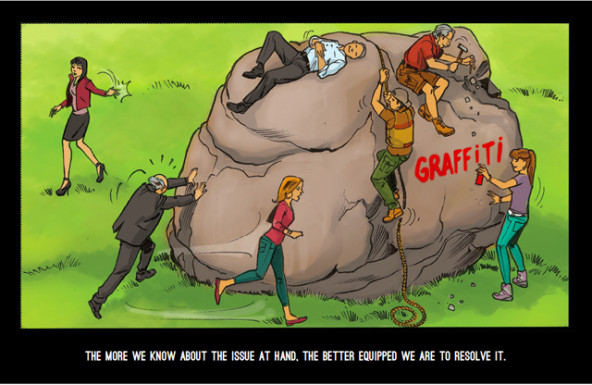 Doing development differently: an image from the guidelines of UNDP’s new scaling competition.
Doing development differently: an image from the guidelines of UNDP’s new scaling competition.
We recently came across a story that got us thinking about how we at United Nations Development Programme (UNDP) do development: Crickets in Hawaii have gone quiet.
It seems that two species of male crickets in Hawaii have evolved an inability to sing so that they can escape killer flies. Chances are these crickets tested out many different ways of escaping the flies (since chirping attracts mates, going silent probably wasn’t their first strategy). Maybe they tried singing during different times of day or from different locations; but in the end, silence (even at the cost of flirting) seems to have worked best. It is now up to the killer flies to figure out a new way of getting their cricket-lunch.
If we took a page out of crickets’ book on, say, tackling corruption in governance, we would assume from the beginning that no matter what initiative idea we start with, the real-world reaction to it would push us to adapt the initiative or come up with something else entirely. So how would we go about designing development projects knowing that our solution is temporary and needs to keep changing over time?
How do we create the space for constant adaptation in bureaucracies that are predicated upon predictability, risk aversion, and stability?
Are you enjoying this article? Read more like this, plus SSIR's full archive of content, when you subscribe.
This was one of the major questions that arose during a recent discussion in New York, where we brought together development professionals with ecologists, psychologists, and cognitive scientists to try something new (with special thanks to Dave Snowden).
What if we applied natural and biological processes to scaling up (or evolving) development initiatives? Could it help us avoid the trap of equating scaling with bigger, faster, and cheaper projects?
In the spirit of learning by doing, we followed the conversation in New York with a new kind of scaling-up competition for our 25 offices in Europe and Central Asia.
With this challenge, we approached at least two questions in a fundamentally new way:
What do we scale up?
Instead of picking “winning” initiatives from within the organization or focusing on a search for new ideas, we urged teams to look out for cases of positive deviance in their communities—outliers who could make things move in seemingly dead-end places and with existing solutions.
This changes the question, “What do you think a potential solution should be?” becomes “What are you already doing to solve it?”
The idea is to bring in new voices and different ideas from citizens living on the edge of society and to source existing innovative approaches to longstanding social problems. The scientists with whom we worked indicated that marrying local initiatives and know-how with international technical expertise may produce “more evolvable” ideas.
In other words, if we’re properly clued in on starting conditions and local context, we may be in a better position to invest in initiatives that are more likely to grow. As Center for Global Development Director Owen Barder points out, our challenge in development is knowing not only which simple inputs are the most cost-effective, but also how to reach people with those inputs.
How do we scale up?
A start-up is not a smaller version of a bigger company in the same way that a company isn’t a larger version of a start-up. Similarly, assuming that we can standardize a social service developed in one place and apply it somewhere else (which pretty much sums up a prevailing approach to scaling in development) overlooks a series of things, such as adaptation and reinvention, that may make that social service more relevant and fit for a given setting.
So, as Jesper Christiansen from MindLab writes, success for us isn’t just one scaled solution, but multiple prototypes that local teams take forward. By identifying those local teams and empowering them to refine and move forward with their ideas, we’re hoping to create a school of fish not a whale—quick to move, and adaptable to rapidly changing and sometime volatile socio-political circumstances.
Barder remarks that, unlike venture capitalists, scaling up in development is more like building a series of separate businesses from scratch, each in a different market. Much like those crickets in Hawaii, we’re simultaneously testing a number of different ways to solve a problem, continually scanning the horizon to see which aspects of which strategies may work and evolve, or which ones people will take up and which ones they won’t. We are excited to see where it goes.
Support SSIR’s coverage of cross-sector solutions to global challenges.
Help us further the reach of innovative ideas. Donate today.
Read more stories by Milica Begovic Radojevic & Giulio Quaggiotto.

